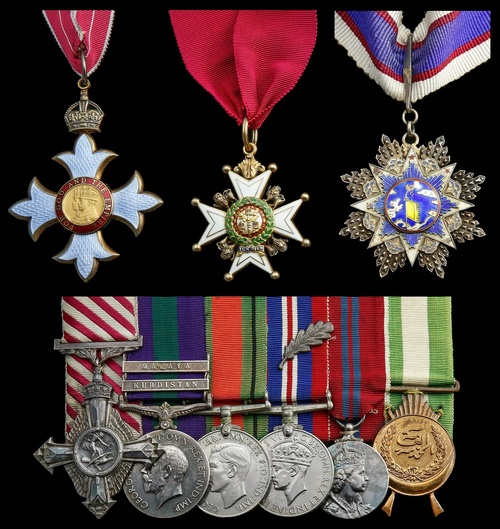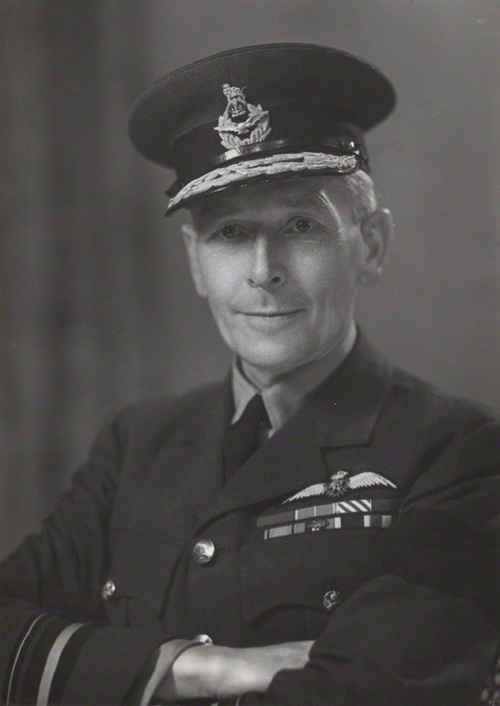Auction: 17003 - Orders, Decorations and Medals
Lot: 716
(x) A rare and impressive post-war C.B., Second World War C.B.E., inter-war test pilot's A.F.C. group of nine awarded to Air Vice-Marshal R. L. Ragg, Royal Air Force, one of a handful British recipients to be awarded the 'Special Cravat' grade of the Chinese Order of the Cloud and Banner
The Most Honourable Order of the Bath (C.B.), Military, Companion's neck badge, silver-gilt and enamel; The Most Excellent Order of the British Empire (C.B.E.), Military, Commander's 2nd type neck badge, silver-gilt and enamel; Air Force Cross, G.V.R., unnamed as issued; General Service 1918-62, 2 clasps, Kurdistan, Malaya (F./O. R. L. Ragg, R.A.F.); Defence and War Medals 1939-45, M.I.D. oak leaf; Coronation 1953; Iraq, King Feisal's War Medal; China (Republic), Order of the Cloud and Banner, 'Special Cravat' Class, neck badge, silver, silvered-metal and enamel, local manufacture with impressed number '1048' to reverse, mounted court-style as worn where applicable, enamel damage to the last, otherwise generally very fine or better (9)
C.B. London Gazette 9 June 1949.
C.B.E. London Gazette 1 January 1945.
A.F.C. London Gazette 30 December 1927.
Robert Linton Ragg was born on 9 April 1901, the son of Robert Stewart Ragg, M.A. (Oxon) and Margaret Elizabeth Christie. Young Robert was educated at the Dragon School, Oxford and Dulwich College.
Active service in Kurdistan
Commissioned Pilot Officer in the Royal Air Force in January 1921, he quickly saw active service as a pilot in No. 45 Squadron in the Kurdistan operations of 1922-24 (Medal & clasp), the future 'Bomber' Harris flying regularly as his Bomb Aimer.
Equipped with Vernon bombers, the unit used them to great effect in transporting troops to trouble spots, in addition to attacking rebel villages.
'Experimental Pilot'
On his return home, Ragg served as an experimental pilot at the Royal Aircraft Establishment in Farnborough in 1925-29, in which role he won the A.F.C. and the Royal Aeronautical Society's Pilcher Memorial Prize in 1926.
A glimpse of Ragg's gallant experimental work is to be found in Lighter Than Air: The Life and Times of Wing Commander N.F. Usborne, R.N., by Guy Warner. This includes mention of a memorable 'parasite flight' from the airship R. 33 in a Gloster Grebe fighter in October 1926.
He was also joint winner - with Flight Lieutenant J. S. Chick, M.C., A.F.C. - of 2nd Prize in Daily Mail Light Aeroplane Competition in the same year; see the Journal of The Royal Aeronautical Society, Vol. 30, No. 191 (November 1926), for an article written by Ragg - 'Experimental Flying from the Pilot's Point of View'.
Iraq
In February 1931, Ragg joined No. 203 Squadron at Basra in Iraq. Equipped with Short Rangoons, the unit undertook anti-piracy and policing duties in the Persian Gulf and led the way forward in establishing new bases, local rulers being entertained in the capacious cabins whenever trouble was brewing. However, as described in an article by Tony Webb, such arrangements were prone to complications; see:
http://ukmamsoba.org/raf%20on%20masirah.htm
'The association of the Royal Air Force with Masirah Island began in April 1933, with the arrival of a party of R.A.F. officers who had come to survey the island with a view to using it as a site for a transit airfield, fuel dump, and seaplane anchorage.
Early in 1931, Flight Lieutenant R. L. Ragg (later Air Vice-Marshal) landed his 'Rangoon' flying boat near Umm Rasays and, to quote from a letter ' … we went ashore in a rubber dinghy under cover of our machine-guns while the Sheikh and his braves came down to the beach to meet us and the old men, women and children retired behind the village among the hillocks. But eventually we made friends with the aid of a few bags of rice - and before my tour at Basra was finished two hard working years later we had established a petrol dump and cleared a landing strip for Wapiti aircraft.
On arrival at Umm Rasys, Flight Lieutenant Ragg, Flying Officer Sarel and Flying Officer Crosbie went ashore and attempted to persuade the natives to convey petrol and oil from the petrol store to the beach as had been arranged in the agreement drawn up on 16 November 1932 with Sheikh Khamis bin Hilal. This, however, they refused to do, demanding one Maria Theresa for the transportation of every eight tins (The price agreed on with the Sheikh had been one anna for every two tins).
Petrol and oil was therefore transported by the officers and crew of the S-1433 from the petrol store to the beach, from where the boatmen caretaker employed by Salim bin Said was persuaded to convey it to S-1433.
The petrol and oil had been carefully stowed in the store-house but several tins of petrol were leaking. The conveying of 70 tins of aviation fuel and 3 drums of oil from the storehouse to the flying boat and the refuelling took 3½ hours, no assistance whatever being obtained from the natives, who became almost truculent until the Sheikh himself arrived about 1½ hours after refuelling had started.
Although the Sheikh was friendly he did not order the services of the natives. In the absence of the interpreter it was a little difficult to discuss the situation, but it was understood that the Sheikh was perplexed as to the method of payment for the labour. It was impressed upon him, however, that by noon the following day 70 tins of petrol were required on the beach with the 'houri' ready to take it off to the flying boat as soon as she had anchored.'
The outcome of the stand-off remains unknown but the island was later established as a fuel store for aircraft of the Royal Air Force and of Imperial Airways flying between Aden and India. The first Royal Air Force aircraft to land on the strip were a flight of Wapitis, which were flown from Iraq and which navigated from old Admiralty charts of the coast.
The Second World War - and beyond
Ragg, who graduated from the R.A.F. Staff College as a Wing Commander in 1937, went on to hold three senior commands in the Second World War, namely those of Command Navigation Officer, Bomber Command (1939-40); Senior Air Staff Officer, No. 15 Group (1943-44), for which he was awarded the C.B.E. and mentioned in despatches (London Gazette 14 January 1944, refers); and Deputy Air Officer Commanding No. 222 Group, Ceylon (1944-45), in which role he was again mentioned in despatches (London Gazette 8 June 1944, refers).
Post-war, he served as Air Officer Commanding, British Armed Forces, S.E.A. (later Air Headquarters, India) (1945-46), gaining the rare distinction of the 'Special Cravat' Class of the Chinese Order of the Cloud and Banner (London Gazette 11 February 1947, refers).
Having then served as Air Officer Commanding No. 63 Group, R.A.F., he was advanced to Air Vice-Marshal and appointed Senior Air Staff Officer, Transport Command (1948-1949), in which capacity he was awarded the C.B. He was next appointed Senior Air Staff Officer, Far East Air Force (1949-1951) and thereby qualified for the 'Malaya' clasp to his General Service Medal, a rare 'marriage' indeed to his earlier 'Kurdistan' clasp.
Following a brief appointment as Director-General of Personnel at the Air Ministry in 1952, Ragg was appointed Air Officer Commanding No. 18 Group, R.A.F. and Senior Air Force Officer, Scotland. His final appointment was as Air Commander, Northern Sub-Area, Allied Atlantic Command, N.A.T.O. (1952-55), in which latter year he was placed on the Retired List.
In retirement, the Air Vice-Marshal busied himself with a string of educational appointments, among them Bursar of Gordonstoun School (1955-1957); County Commander for Scouts in Cornwall (1958-1962); Chairman of the Cornwall County Air Training Corps Committee and as a member of the Memorial Board of Governors at Truro Cathedral School. He died in Somerset on 19 December 1973, aged 72.
Subject to 5% tax on Hammer Price in addition to 20% VAT on Buyer’s Premium. For more information please view Terms and Conditions for Buyers.
Sold for
£3,400







